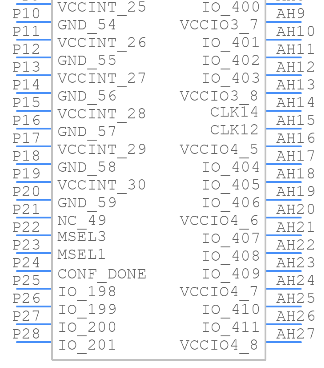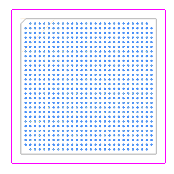EP4CE75F29I7N FPGAs: Features, Applications and Datasheet
2025-05-23 11:30:48 1163
EP4CE75F29I7N Description
The EP4CE75F29I7N is a high-density, low-power FPGA from Intel’s (formerly Altera) Cyclone® IV E family. Engineered to balance performance and cost, it is built on a 60-nm process and provides a robust platform for mid-range logic applications requiring efficient computation, abundant I/Os, and substantial memory. Housed in a 896-ball FineLine BGA (FBGA) package and rated for industrial temperature ranges, this device is ideal for harsh or mission-critical environments.
EP4CE75F29I7N Features
Logic Elements (LEs): 74,880
Embedded Memory: 3,888 Kbits of M9K RAM
I/Os: Up to 492 user I/O pins
Embedded Multipliers: 156 × 18x18 multipliers for DSP
Package: FBGA-896
I/O Standards Support: LVTTL, LVCMOS, SSTL, HSTL, and differential I/O like LVDS
Configuration Options: JTAG, Active Serial (AS), Passive Serial (PS)
Operating Temperature Range: -40°C to +100°C (industrial grade)
Low static and dynamic power consumption
EP4CE75F29I7N Applications
Industrial Automation Controllers
Video and Image Processing Systems
Medical Equipment
Communications Infrastructure
Embedded Vision and Robotics
High-Performance Motor Control
EP4CE75F29I7N CAD Model
Symbol

Footprint

3D Model


EP4CE75F29I7N Alternatives
If EP4CE75F29I7N is unavailable or over-spec’d for your needs, consider these alternatives:
EP4CE55F23I7N – Lower LE count (55K), still Cyclone IV E family, cost-effective.
EP4CGX75DF29C7N – Cyclone IV GX family with high-speed transceivers.
10CL080YU484I7G – From the Cyclone 10 LP family with comparable density.
LFE3-70EA-6FN672C – From Lattice ECP3 family, suitable for mid-density applications.
Xilinx Artix-7 XC7A75T-2FGG484I – Comparable LE count, with additional DSP support and flexibility.
EP4CE75F29I7N Manufacturer
Intel Corporation is a global technology leader headquartered in Santa Clara, California, renowned for designing and manufacturing advanced semiconductor products. Founded in 1968, Intel is best known for its microprocessors, which power a significant portion of the world's personal computers and servers. Over the decades, Intel has expanded its product portfolio to include graphics processors (GPUs), field-programmable gate arrays (FPGAs), networking components, memory solutions, and artificial intelligence accelerators. With a strong focus on innovation, performance, and security, Intel plays a pivotal role in enabling technologies that drive data centers, edge computing, autonomous systems, and consumer electronics. The company is also committed to building a more open and sustainable computing ecosystem.
EP4CE75F29I7N FAQs
1. What are the main timing characteristics of the EP4CE75F29I7N FPGA?
The typical maximum core performance can exceed 250 MHz, depending on logic configuration, with precise timing analysis handled via the Quartus II software suite.
2. How many PLLs are available in the EP4CE75F29I7N for clock management?
This device includes 4 embedded PLLs, allowing for multiple clock domains, phase shifting, and frequency synthesis across different subsystems.
3. Is the EP4CE75F29I7N suitable for high-speed differential signaling like LVDS?
Yes, it supports true differential I/O standards like LVDS, mini-LVDS, and RSDS, making it suitable for high-speed serial data links.
4. Can the EP4CE75F29I7N be used in applications requiring ECC (Error Correction Code) memory?
While ECC is not natively built into the M9K RAM blocks, soft ECC logic can be implemented using LEs to protect data stored in on-chip memory.
5. What development tools and IP cores are compatible with EP4CE75F29I7N?
This FPGA is fully supported by Intel Quartus II software, including IP cores for memory interfaces, DSP functions, Nios® II soft processor, and various connectivity protocols like UART, SPI, and Ethernet.




